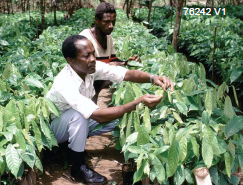The Economics of Adaptation to Climate Change Study: Ghana


Lessons and Policy Recommendation
AgricultureThere is a need to (a) increase investment in agricultural R&D, backed by extension services, to produce new crops and livestock, as well as early-maturing varieties; (b) improve water storage capacity to utilize excess water in wet years and use it when it is needed during dry years; (c) improve agricultural and livestock extension services and marketing networks; (d) construct small to mid-size irrigation facilities; (e) improve entrepreneurial skills to generate off-farm income (alternative livelihoods); and (f) improve access to loans and microcredit.
Road transportRecommended actions include proper timing of road construction; for example, before the rainy season. There is also a need to ensure routine and timely maintenance; review overall road design criteria, including materials and drainage, road sizes, and protection of road shoulders; and reform road design standards to meet higher needs against extreme events such as floods and droughts.
Water and energyRecommended hard options for the water subsector include increased water transfer from the Volta basin to meet the needs of a growing urban population; construction of efficient infrastructure; and blocking of dry-stream channels to harvest rainwater to recharge the groundwater system, which serves as an alternative water supply during dry years. A number of soft options were also deemed to be of high priority: afforestation, improved land use practices, protection of river courses, and desedimentation of reservoirs. Diversification of the energy mix and development of renewable sources—such as solar, wind, biomass, waste conversion, and mini-hydro dams—are priorities, as are soft options such as promoting policies and measures aimed at enhancing energy efficiency in all sectors. The government also should commit to a strict infrastructure maintenance regime.
Coastal zoneThe modeling results generally show that the investment costs of coastal zone adaptation are likely to be uneconomic because the costs are likely to far exceed any benefits, so defending the entire coastline by building dikes and sea defense walls is not a sensible strategy. A better strategy would be to protect key investments and natural resources—ports, harbours, beaches, and coastal mangroves— and to zone significant new infrastructure away from vulnerable areas to the greatest extent possible. Emphasis must be placed on soft options such as enhancing capacity in early warning systems and the use of GIS and satellite imagery for coastal zone management. New oil and gas development and related infrastructure and regional development in the Western region would need to be designed with climate change adaptation in mind.
Social dimensionsComplementary investments in both hard and soft adaptation options are needed to ensure effective use of infrastructure and to meet the needs of the poorest. Adaptation investments in hard infrastructure without complementary investments in policy, service, and extension support will not operate in an optimally efficient manner. A policy shift is needed—from support for coping strategies for climate shocks at the household level, to transformative adaptation strategies that can increase resilience at the household and area level. The poorest are particularly vulnerable to climate shocks, as they do not have stored assets to use during times of stress. A pro-poor approach to climate change adaptation would look not only at reducing shocks to households, but also engage in transformative adaptation strategies that increase resilience and overcome past biases in subnational investment. Geographically targeted, multisectoral interventions are needed to reduce the “development deficit” of vulnerable regions. Poverty and sensitivity to climaterelated hazards are increasingly concentrated in particular regions within the country. In many cases, poor communities—such as recent urban inmigrants—are relegated to the most marginal areas of the city. Adaptation policies at the national level must take into account the diverse socioecological settings within the country, and devise area-specific interventions that can support the livelihoods of these vulnerable populations. Multisectoral interventions that aim to improve area resilience through reducing the development gap are particularly effective forms of investment, including programming in education, social protection and health, roads, market services, natural resource management, and skills training.
Regional integrationIt is important for Ghana to strengthen dialogue with neighboring countries to effectively deal with the challenges of climate change. Areas where negotiations and consultations would be required are in the management of shared water resources and regional migration of people.
Long-term planningGiven the development challenges and threats posed by climate change and variability, Ghana needs a a long-term national plan that takes these factors into account. Currently, Ghana only has a medium-term development plan covering 2010–13. The long-term plan also needs to be integrated into the plans of the regional coordinating councils and the district development plans to provide a coherent and integrated approach to development planning.
(0) Comments
There is no content